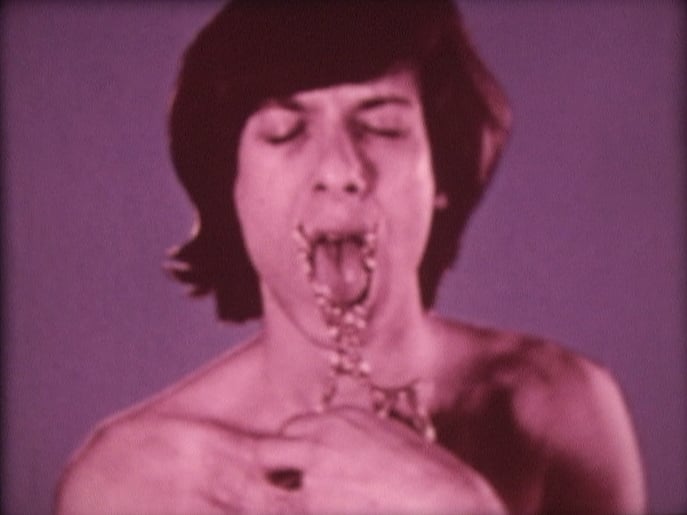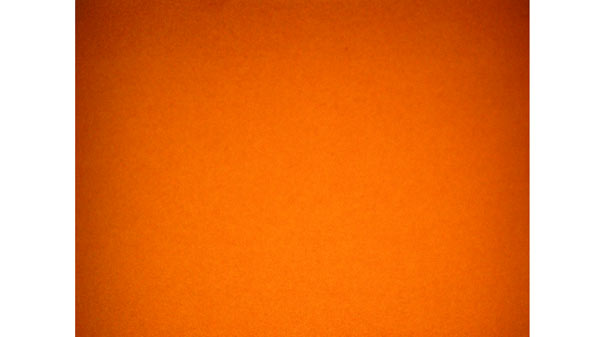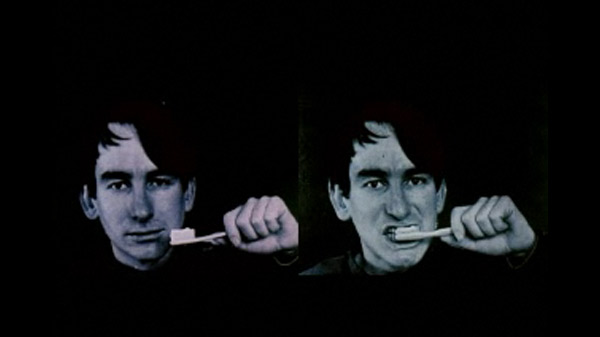Produced with the aid of a CAPS Award (1978). sound portion made possible by the facilities of the Computer Science Center at Carnegie Mello University and ZBS Foundation (through funding by the New York State Council on the Arts and National Endowment to the Arts).
This is a 4 section single-screen version of a 4 screen continuous projection film/sound installation (‘location’). The film was conceived to function in both formats. In the installation format, the images are all turned sideways and are aligned one next to the other, successively, each image is more complex and there is an obvious progression. As a single-screen work, each section of the film becomes more complex so there is a felt progression.
The first image is a filmstrip, apparently flowing downwards, the frames of this strip are just blank colours and some of the frames are black (what is being re-photographed is ‘Specimen IV’, part of the film ‘Analytical Studies IV: Blank colour Frames’). On the right edge of the screen, sprocket holes are seen, on the left edge a white undulating line – an optical soundtrack – is seen, off center, to the right, in the frame area of the strip, there is a continuous white, jagged scratch which, while thinner than the optical soundtrack strand, has contours roughly related to it. We notice that the ‘movement’ of the scratch is constant even though the filmstrip image shifts speeds, in fact the scratch is not on the rephotographed strip but is on the actual filmstrip going through the projector – or so it seems. Another incongruity is noticed: the soundtrack is moving upwards, as if disjointed from the filmstrip it should be part of, its speed of movement is also quite out of relation to that of the strip. Beginning with section II, each section of the film is a re-recording of the former section. The second section ‘encloses’ the first, in both image and sound, therefore now we see a set of sprocket holes – one strip in another. The third section ‘contains’ (and is a product of) the second (and the first). The fourth section ‘contains’ the images of Sections I,II and III. Of course, there are varied modulations of rephotographed speeds, giving rise to some curious images of strip ‘motion’. In the 4-screen version, it appears as if the strips from one segment flow into the next, becoming progressively more compressed, as if ‘collapsing’, from the first image of a single strip into the fourth image of all the succeeding sections. The film’s soundtrack, a spoken text regarding the nature of optical soundtracks, through a series of analogue-to-digital transformations, is a sort of sound analogue of what happens in the visual track: one hears the entire text section in Section I, hears it (compressed) twice in section II, and so on: the text is compressed in such a way that it does not change pitch, which is what normally occurs when a recording is sped up (‘compressed’). The first compression was done by a computer program created for me in 1973-4 by Christopher Copper, at Carnegie Mellon, all the pauses between words and the fragments of silences within words, were selectively removed by the computer, the text was jammed up making it half its original length, this created a very rapid, but still intelligible flow of speech, which seems intentionally rhythmical (whereas the text was actually spoken in an intentionally uninflected monotone). The image one sees of the optical soundtrack is, in fact, made from this first compression, it is purely a soundtrack since all silences have been removed from the text. n 1978, the final work on the soundtrack was done at ZBS Foundation, using an analogue-to-digital processor called a harmonizer . The Carnegie Mellon tape was first re-expanded to its original length by ‘stretching’ it, without however reintroducing pauses and silences-it remained purely a soundtrack. The harmonizer can expand or compress sounds without altering pitch. This re-expanded track, which appears in Section I, is quite legible but its auditory effect is rather unnatural. In Section II the Carnegie Mellon tape is heard, twice. (Note: the sections of the film are exactly the same length.) The track for Section III was generated by compressing the Carnegie Mellon track about 70% and it is repeated about 3 times, here the text is on the very borderline of comprehension. In Section IV, the Carnegie Mellon track is compressed to about 50% and is repeated 4 times in succession, the text becomes unintelligible (but remains very rhythmic). The visual ‘degeneration’ of the image of Section I, through successive rephotography , is parallelled by the compression of verbal information to the point of its loss of legibility, yet both the ‘degenerated’ sound and image are perceptibly engaging, even in the most advanced stages of ‘degeneration’. It is obvious why the film has its title, because of the strategies of its coming into being, but, paradoxically at the level of effect, its dynamics arise from its ‘Episodic Degeneration’.
‘Episodic Generation indicates Sharits ‘ increasing involvement with sound since 1973. His work of this period, the silent Declaritive Mode aside, constitutes an important achievement and the exploration in the area of sound alone.’ – Brian Henderson.






